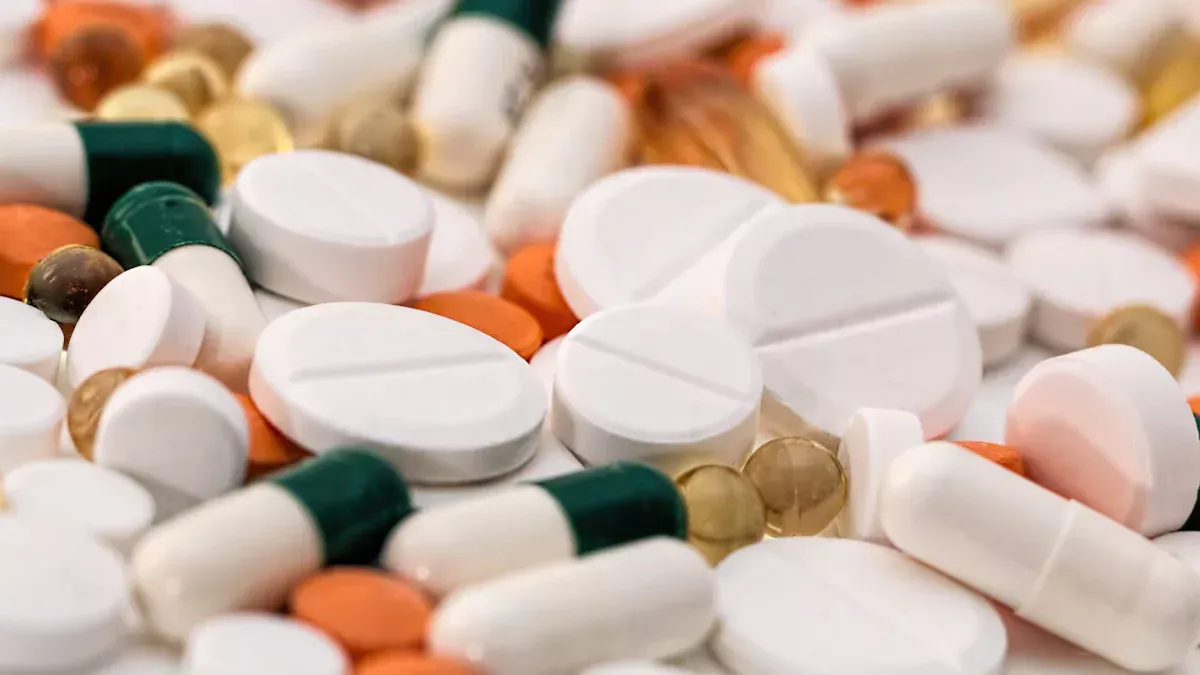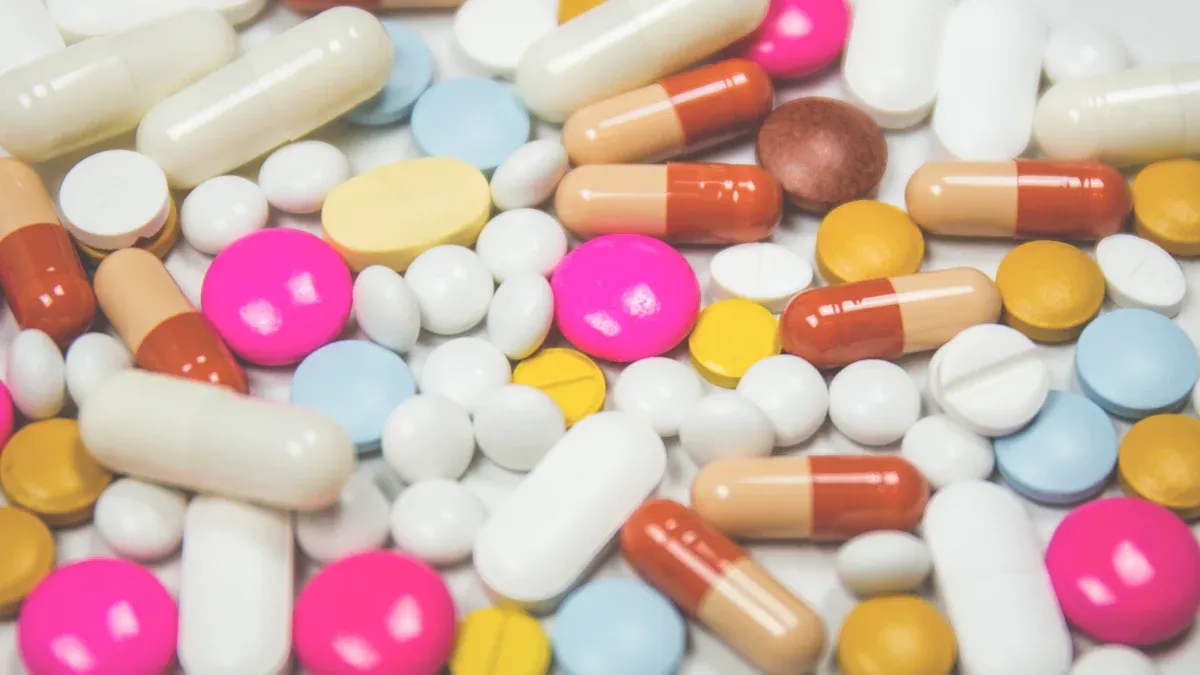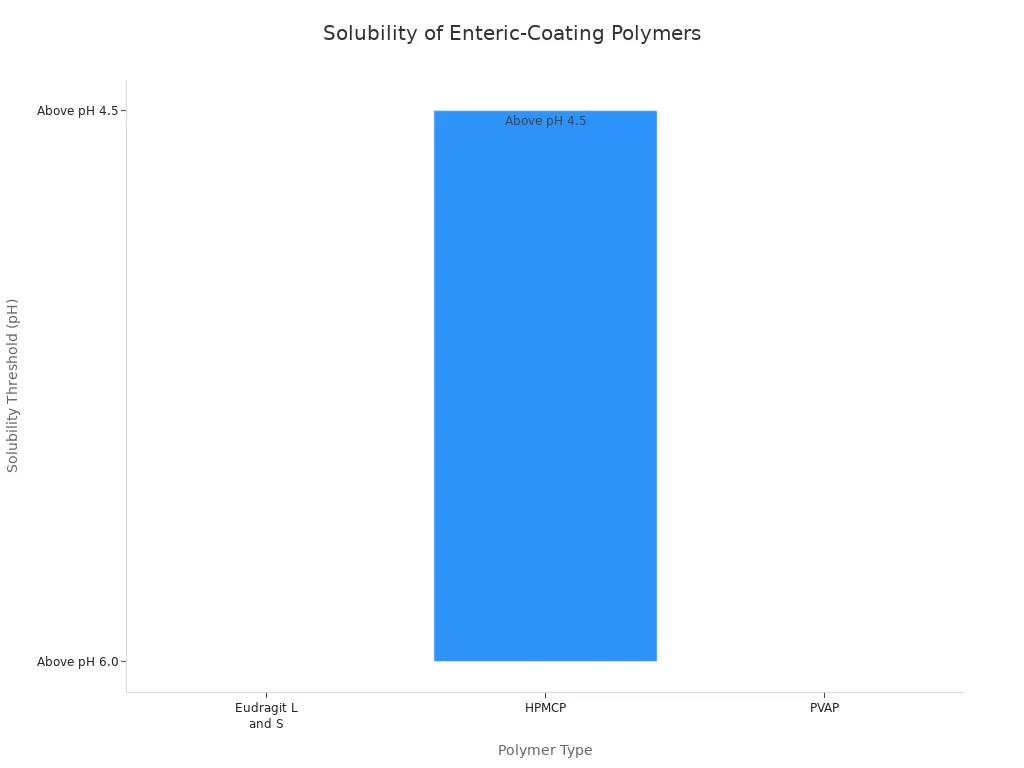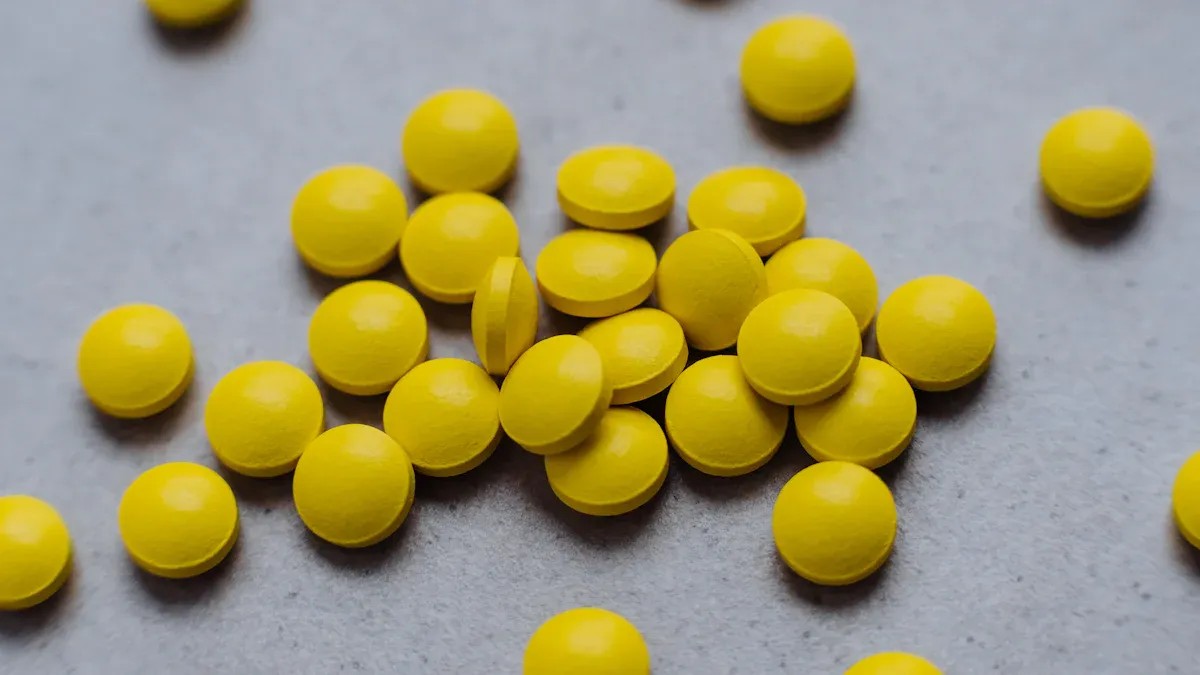Views: 0 Author: Site Editor Publish Time: 2025-09-30 Origin: Site









You might feel confused when you see enteric-coated tablets and film-coated tablets at the pharmacy. The biggest difference is that enteric-coated tablets keep medicine safe from stomach acid, so they break down in your intestine, not your stomach. Film-coated tablets have a thin layer that makes them taste better or easier to swallow, but they usually let the medicine out right away in your stomach. Studies show that enteric-coated aspirin and uncoated aspirin work the same for heart health and safety.
Enteric-coated tablets keep medicine safe from stomach acid. They let the medicine dissolve in the intestine. This is good for drugs that do not like acid.
Film-coated tablets help cover bad taste and are easier to swallow. They let medicine out fast in the stomach. They do not protect it from acid.
Pick enteric-coated tablets if your stomach gets upset. Use them if you need the medicine to work in the intestines. Ask your doctor to help you choose.
Each coating has its own job. Enteric coatings protect and help medicine work in the right place. Film coatings help with taste and swallowing.
Always listen to your doctor about taking coated tablets. Do not crush or break them. This can make them not work right.

Enteric-coated tablets have a special layer on the outside. This layer does not break down in your stomach. It stays whole until it gets to your small intestine. The main reason for this is to keep some medicines safe from stomach acid. Some drugs, like omeprazole and erythromycin, can lose their power in acid. The coating also helps stop your stomach from getting irritated. This can happen with medicines like aspirin.
Tip: If your stomach is sensitive or you need medicine to work in your intestines, your doctor might give you this kind of tablet.
Here is a table that shows the main chemical and functional differences between coatings:
Ingredient Category | Function | Examples | Solubility Profile |
|---|---|---|---|
Film-coating polymers | Make tablets look better and protect from air and water | Hydroxypropyl methyl cellulose (HPMC) | N/A |
Enteric-coating polymers | Only dissolve in the intestine, not the stomach | Acrylate polymers (Eudragit L, Eudragit S) | Above pH 6.0 |
Hydroxypropyl methylcellulose phthalate (HPMCP) | Above pH 4.5 | ||
Polyvinylacetate phthalate (PVAP) | Above pH 6.0 |
You can see enteric-coating polymers only break down at higher pH levels. These levels are found in your intestines. This makes them good for drugs that should not break down in your stomach.

Some health problems need this kind of coating. For example, if your medicine can upset your stomach or needs to get to your colon, enteric-coated tablets are best. Doctors may also give them for night-time use, so the drug works when you wake up.
Clinical Scenario | Description |
|---|---|
Stability of APIs | Keeps drugs safe that break down in stomach acid, like erythromycin |
Minimizing Side Effects | Lowers side effects like nausea and irritation from drugs like aspirin |
Night-time Dosing | Makes sure the drug works when you wake up |
Colonic Drug Delivery | Helps send medicine straight to the colon |
Film-coated tablets look shiny and smooth. They are easier to swallow and taste better. The film coating is a thin layer you can eat. It covers the tablet and keeps the medicine safe from air and water. This helps the tablet last longer. Film coatings do not stop the tablet from breaking down in your stomach. Most film-coated tablets start to dissolve as soon as they reach your stomach.
Note: Film-coated tablets can sometimes change how fast the medicine comes out, but they do not protect against stomach acid.
Here is a table that compares how different coatings dissolve in your body:
Coating Material | Dissolution Rate in Simulated Gastric Fluid | Dissolution Rate in Simulated Intestinal Fluid |
|---|---|---|
Polyvinyl Acetate Phthalate | Slower | Faster |
Cellulose Acetate Phthalate | Slower | Slower |
Film-coated tablets often use hydroxypropyl methyl cellulose (HPMC) as the main ingredient. This helps the tablet look nice and last longer on the shelf. Film-coated tablets are common for medicines that do not need protection from stomach acid.
Pharmaceutical rules say film coatings make tablets easier to hold and swallow. They also make the taste better and can help control how fast the medicine comes out. But they do not protect sensitive ingredients from acid, so they are not good for every drug.
You might wonder how these tablets protect medicine. Enteric-coated tablets have a special layer outside. This layer stays solid in your stomach. It does not dissolve in stomach acid. When the tablet reaches your intestine, the coating breaks down. The medicine comes out in your intestine. Your body can absorb it there without damage. This helps drugs that lose strength in acid. Medicines like omeprazole and diclofenac need this protection to work.
Tip: If your doctor says your medicine is sensitive to acid, you will probably get an enteric-coated tablet.
Enteric-coated tablets have many good points for you:
They help lower stomach pain, bloating, and discomfort from some medicines.
You may have fewer side effects like burping or gas than with uncoated tablets.
These tablets help some drugs get absorbed better in your intestine, so you might need a smaller dose.
The coating helps medicines like DX-9065 and omeprazole get into your body more easily.
You get protection from bad reactions with bile acids, which matters for drugs that do not pass easily through your gut wall.
Enteric-coated tablets help many people, but they have some downsides:
Some people still get side effects like indigestion, stomach pain, or bleeding.
The coating does not always stop all stomach or bowel problems. For example, aspirin with this coating can still hurt your small bowel.
You might see bruising or other mild side effects if you take these tablets for a long time.
Note: Always talk to your doctor if you have stomach pain or strange symptoms while taking these tablets.
When you take a film-coated tablet, the coating starts working fast. The coating is a thin layer that covers the tablet. This layer helps the tablet slide easily in your mouth. It also helps the tablet go into your stomach. In your stomach, the coating melts quickly. Most film-coated tablets break down in 2.5 to 10 minutes. This lets your body take in the medicine fast. Fast action is important for drugs that need to work quickly.
The coating also changes how water moves inside the tablet. As the coating melts, the polymer forms a gel. This gel controls how water gets into the tablet. This step helps the tablet release medicine at the right time. You get the full effect of your medicine without waiting long.
Tip: If you need medicine to work fast, film-coated tablets are a good choice.
Film coating gives you many good things as a patient:
You do not taste bitter medicine because the coating blocks the flavor.
The coating makes tablets easier to swallow and hold.
The coating keeps medicine safe from water, light, and air.
This helps the drug stay fresh and stable.
The coating hides bad flavors, so you are more likely to take your medicine.
Different polymers can control how medicine comes out in your mouth and stomach.
The coating stops the tablet from breaking or making dust.
The coating helps protect drugs that break down in water.
The coating makes your medicine last longer by blocking water and air.
The coating is safe for your body and does not hurt you.
The coating lets companies make tablets that look smooth and shiny.
Here is a table that shows how film-coated tablets compare to uncoated tablets:
Aspect | Film-Coated Tablets | Uncoated Tablets |
|---|---|---|
Manufacturing Complexity | Needs careful steps and skill to coat each tablet. | Easier to make with fewer steps. |
Cost | Costs more because it uses better materials and new technology. | Costs less since there is no extra coating. |
Quality Control | Needs regular checks to make sure every tablet is the same. | Needs fewer checks for quality. |
You may see some problems with film-coated tablets:
The coating adds more steps and cost to making tablets.
Sometimes, the coating does not fully protect drugs from water.
Water can still get in and lower the medicine amount.
The coating may slow down how fast the tablet breaks apart if the gel is too thick.
You might pay more for film-coated tablets because of the special coating.
The coating needs careful checks to make sure every tablet works right.
Sometimes, the coating can make the tablet break down faster if it traps water inside.
Note: Always ask your pharmacist if you have questions about the coating or if you notice changes in your medicine.

Have you ever thought about how medicine gets its coating? Companies use special steps to make sure each tablet works well. Here is what happens:
Preparation of the coating solution: First, workers mix polymers, plasticizers, and colorants with a solvent. This makes the main liquid for the tablet coating.
Application: Next, the coating solution is sprayed on the tablets. The tablets spin in a pan or move in a fluid bed. This covers every side of each tablet.
Drying: Then, warm air blows over the tablets. This dries the coating fast and helps it stick to the tablet.
Tip: Workers must watch the coating process closely. This makes sure every tablet gets the same amount of coating and works right in your body.
There are some big differences between enteric and film coatings. Both use almost the same steps, but the materials and results change.
Film coatings use a thin layer. This layer adds only 2–3% to the tablet’s weight. It helps you swallow the tablet and keeps it safe from air and water.
Enteric coatings use special pH-sensitive polymers. These coatings stay solid in your stomach. They only melt in your intestines. This protects drugs that could break down in acid or hurt your stomach.
Here is a table to help you see the differences:
Feature | Film Coating | Enteric Coating |
|---|---|---|
Thickness | Thin (2–3% weight gain) | Thin to moderate, pH-dependent polymer |
Purpose | Protects tablet, improves swallowability | Delays release until reaching intestines |
The biggest difference is where the tablet coating melts. Film coatings break down in your stomach. Enteric coatings wait until the tablet gets to your intestine. This helps keep your medicine safe and protects your stomach.
When you pick between enteric-coated and film-coated tablets, think about what you need. Some people have stomachs that get upset easily. If you feel pain after taking medicine, enteric-coated tablets might help you. This coating can stop your stomach from getting irritated. You should also think about how you take your medicine. Do not break or crush enteric-coated tablets. Film-coated tablets can sometimes be chewed or crushed, but you should always read the instructions first.
Here is a table to help you compare:
Factor | Enteric Coating | Film Coating |
|---|---|---|
Correct Administration | Should not be broken or crushed | Can be chewed or crushed (check instructions) |
Avoiding Side Effects | Protects against stomach irritation | May not protect against stomach acid |
Medication Interactions | Helps reduce stomach irritation | May not provide protection |
Medication Safety | Safe for drugs that irritate the stomach | Generally safe, but less specific protection |
Think about how easy it is to swallow your medicine. Many people like tablets that are shiny and slippery because they are easier to swallow. Some people like certain colors or shapes, which can help them remember to take their medicine. If you do not like the taste or look of a tablet, you might skip taking it. This can make you miss doses and hurt your health.
Healthcare workers say the way a tablet looks and feels can change if you take your medicine. Some people do not want medicine because of its color or texture. Always talk to your doctor or pharmacist if you have trouble swallowing or do not like how your medicine looks.
The kind of medicine you take is important too. Some drugs break down in stomach acid or can hurt your stomach. For these drugs, enteric-coated tablets are best. They keep the medicine safe until it gets to your intestines. This helps the drug work better and keeps your stomach safe.
Film-coated tablets are good for drugs that do not need special protection from acid. The coating can help the tablet last longer and control how fast the medicine comes out. Some coatings, like HPMC, keep the drug safe from water and light. This helps your medicine stay strong and makes it easier for you to take it because you know it will work.
You should always ask your doctor which coating is best for you. They will look at your health, your medicine, and what you like. This helps you get the best results and makes sure you take your medicine.
When you swallow a tablet, it goes into your digestive system. The absorption site is where your body takes in the medicine. Enteric-coated tablets have a special job. They move through your stomach without breaking down. These tablets wait until they reach your small intestine, especially the distal ileum. Then, they start to release the medicine. This helps protect your stomach and makes sure the medicine works in the right place. You get drug release in the spot that helps with certain health problems.
Film-coated tablets work in a different way. Their coating does not control where the medicine is absorbed. When you take a film-coated tablet, the coating dissolves in many places in your digestive tract. Drug release can happen in your stomach, your small intestine, or even sooner. You do not get targeted drug release like with enteric-coated tablets. Drug release can start as soon as the tablet reaches your stomach. Drug release is less exact with film-coated tablets.
Drug release profiles show how and when medicine comes out of the tablet. Enteric-coated tablets have a special drug release pattern. There is a wait before drug release starts. The thickness of the coating controls this wait. If the coating is thick, drug release takes longer to begin. Once drug release starts, the rate stays steady. You get controlled drug release that protects your stomach and delivers medicine where it is needed.
Enteric-coated tablets have a wait before drug release starts. The coating thickness changes this wait.
Thicker coatings mean you wait longer before drug release starts, but the drug release rate stays steady once it begins.
Different subcoating levels change the drug release profile. Lower subcoating levels make drug release faster.
Enteric coatings help control when drug release happens. Subcoatings can slow down drug release if they are thick.
Film-coated tablets do not have a wait time. Drug release starts quickly after you swallow the tablet. You get fast drug release, which is good for medicines that need to work right away. Film-coated tablets do not give you controlled or targeted drug release. Drug release patterns are less steady compared to enteric-coated tablets.
If you need medicine to last longer in your body, your doctor may choose a special coating or tablet design. Sustained drug release keeps medicine in your body for a longer time. This means you do not have to take medicine as often. Drug release is steady and lasts longer, which helps with some health problems.
Tip: Always listen to your doctor about which tablet is best for you. The right drug release profile helps your medicine work better and keeps you safe.
Picking the right tablet coating helps your medicine work well. Enteric-coated tablets keep drugs safe from stomach acid. They let medicine out in your intestine. Film-coated tablets taste better and are easier to swallow. Look at this table to compare:
Feature | Enteric-Coated Tablets | Film-Coated Tablets |
|---|---|---|
Drug Protection | Strong against stomach acid | Good for taste and moisture |
Swallowing Ease | Not designed for easier swallowing | Smooth and easy to swallow |
If you are not sure, ask your doctor or pharmacist. This way, you can choose what is best for your health.
Coated tablets help protect medicine from stomach acid. They also make medicine taste better and easier to swallow. Some coatings help the medicine come out later or more slowly. These features can help your body use the medicine better and for a longer time.
Coated tablets can help your body use more of the medicine. They make sure the medicine gets to the right place in your body. Enteric-coated tablets and modified release tablets keep drugs safe until they reach your intestine. This helps the medicine work longer and better.
Sustained release means the medicine comes out slowly over time. Delayed release means the tablet waits before letting out the medicine. Both types help control how your body takes in the drug. This can help your body use the medicine better and lower side effects.
You should not split or crush coated tablets. Breaking them can stop the coating from working right. This can make the medicine not work as well and may cause side effects. Always ask your doctor or pharmacist before changing how you take your medicine.
Copyright © 2023 Foshan Xingle Machinery Equipment Co.,Ltd. 粤ICP备2023093194号 All rights reserved. Privacy Policy | Sitemap | Support By Leadong